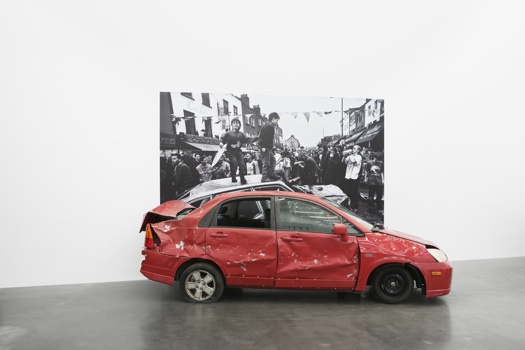
Gustav Metzger, To Crawl Into — Anschluss, Vienna, March 1938 (1996), from retrospective exhibition at the Serpentine Gallery, London. The work is now on view at New York's New Museum. Photo: Geoff Caddick/AFP/Getty Images via The Guardian.
One morning recently I found myself, along with other members of the art press, crawling beneath a large yellow tarp on the fourth floor of the New Museum. Throughout the run of the exhibition "Gustav Metzger: Historic Photographs," museum staff will encourage visitors to replicate this abject form of play. Eventually, they’ll learn that they’ve been crawling on a large photograph of people who are also crawling, and that those people are Jews who were forced to scrub Vienna’s streets in 1938.
The picture is among various images of tragedies — the Holocaust, the Oklahoma City bombing, the Vietnam War — that, since 1990, Metzger has covered, blocked with rubble, or otherwise obscured, forcing us to make an active effort to see them. This series, “Historic Photographs,” uses the humble materials of Minimalism as tools to transform familiar images of destruction and terror into a kind of social sculpture, or even participatory art. The press release suggests that this process compels viewers to engage with the “inescapability and inevitability of evil.” (No wonder the building used to say Hell, Yes.)
The artist, 85, was not at his opening. His refusal to travel, as his refusal to sell his work, or to have a gallery, a computer, or even a phone, is part of a longtime rigorous and hermetic stance. Though he considers himself stateless, he has lived in Britain since arriving on the Kindertransport in 1939, leaving behind his native Nuremberg and his Polish-born parents, who had already been deported and who later died in the camps.

Kill the Cars, Camden Town, London 1996, 1996/2011, exhibited at New Museum. Photo: Benoit Pailley.
A student of the modernist David Bomberg, Metzger gradually moved away from figuration, and then traditional painting. In 1959, he launched his long career of activism and provocation by publishing the Auto-Destructive Art Manifesto, an environmentalist, anti-capitalist missive that was hugely influential to generations of artists (Paul McCarthy writes for this catalogue), writers and musicians. In the audience at a 1963 lecture Metzger gave at Ealing Art College was Pete Townshend, who recalled avidly watching films the artist projected: one of Metzger and Yoko Ono destroying a canvas; another of art students smashing a piano on the street.
“Historic Photographs,” though, is less about destruction than preservation: not just of historical memory, but of the power of art to elicit a visceral response to that history. As many have discovered, it’s a hit-and-miss proposition: Alfred Hrdicka conceived his realist sculpture of a Jew scrubbing Vienna’s streets as a “thorn in the flesh,” but it was treated by pedestrians as a place to snack and by dogs as a place to pee. Peter Eisenman intended Berlin’s Holocaust Memorial to be somber and forbidding, but his field of granite slabs became a haven for hide-and-seek players and sunbathers. Metzger goes a calculatedly passive-aggressive route: harnessing abstraction and figuration, photos and construction materials, he conjures a discomfiting installation that dares you to pay attention and engage with the painful content. In the end, this exhibition is a lot more sentimental than it looks. And it might be just obnoxious enough to work.
